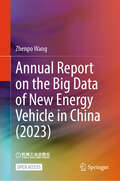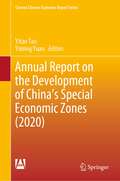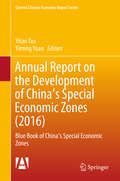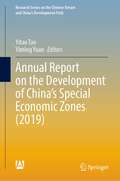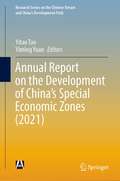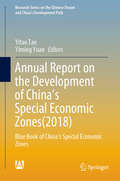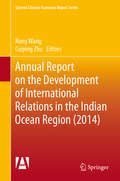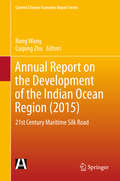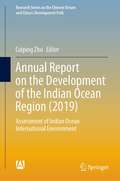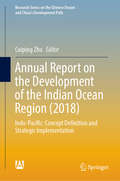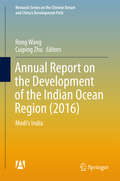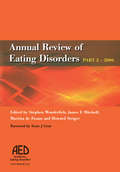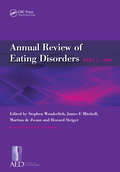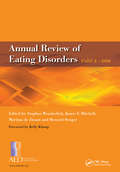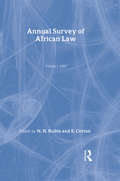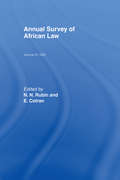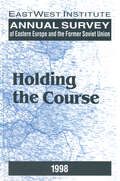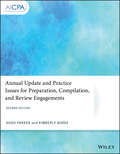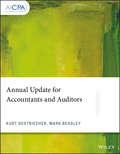- Table View
- List View
Annual Report on the Big Data of New Energy Vehicle in China (2021)
by Zhenpo WangThis open access book, based on static indicators and dynamic big data from local electric vehicles, is the first New-Energy Vehicles (NEVs) research report on the Big Data in China.Using the real-time big data collected by China's National Monitoring and Management Platform for NEVs, this book delves into the main annual technological progress of NEVs, the vehicle operating characteristics, it also anticipates the trend of NEVs industry.Various graphs&charts, detailed data this book offers will familiarize readers with the operation characteristics and practical application of China's NEVs industry and popularize the concept of automobile electrification. Besides, this book also makes an objective evaluation of the current situation and technological improvement of China's NEVs industry, presenting sensible suggestions for the development of the industry.This book is written for government staff, researchers, college staff, and technical staff of automobile andspare parts enterprises, which serves as an important reference for the decision-making of government departments and strategic decisions of automotive companies.
Annual Report on the Big Data of New Energy Vehicle in China (2022)
by Zhenpo WangThis is an Open Access book. This book based on static indicators and dynamic big data from local electric vehicles, is the first New-Energy Vehicles (NEVs) research report on the Big Data in China. Using the real-time big data collected by China's National Monitoring and Management Platform for NEVs, this book delves into the main annual technological progress of NEVs, the vehicle operating characteristics, it also anticipates the trend of NEVs industry.Various graphs & charts, detailed data this book offers will familiarize readers with the operation characteristics and practical application of China's NEVs industry and popularize the concept of automobile electrification. Besides, this book also makes an objective evaluation of the current situation and technological improvement of China's NEVs industry, presenting sensible suggestions for the development of the industry.This book is written for government staff, researchers, college staff, and technical staff of automobile and spare parts enterprises, which serves as an important reference for the decision-making of government departments and strategic decisions of automotive companies.
Annual Report on the Big Data of New Energy Vehicle in China (2023)
by Zhenpo WangThis open access book, based on static indicators and dynamic big data from local electric vehicles, is the first research annual report on the Big Data of New Energy Vehicles (NEVs) in China. Using the real-time big data collected by China's National Monitoring and Management Platform for NEVs, this book delves into the main annual technological progress of NEVs, the vehicle operating characteristics, and it also anticipates the trend of NEVs industry. Various graphs and charts and detailed data this book will familiarize readers with the operation characteristics and practical application of China's NEVs industry and popularize the concept of automobile electrification. Besides, this book also makes an objective evaluation of the current situation and technological improvement of China's NEVs industry, presenting sensible suggestions for the development of the industry. This book is written for government staff, researchers, college staff, and technical staff of automobile and spare parts enterprises, which serves as an important reference for the decision-making of government departments and strategic decisions of automotive companies.
Annual Report on the Development of China's Special Economic Zones (Current Chinese Economic Report Series)
by Yitao Tao Yiming YuanThis book is an overview of the development status of China's special economic zones in 2020, including the reform pilot zones and some new special zones over the past year. It analyzes the challenges during the transformation faced by special zones, the use of resources and sustainable development, economic and social development, social security, science and technology innovation, financial system reform, and cultural industry. Also it includes a record and review of the development status of the five traditional special economic zones and Shanghai Pudong New Area and Tianjin Binhai New Area over the past year, with emphasis on case studies of different special zones.
Annual Report on the Development of China's Special Economic Zones: Blue Book of China's Special Economic Zones (Current Chinese Economic Report Series)
by Yitao Tao Yiming YuanThe Annual Report objectively reflects the year's developments in terms of politics, the economy, society, culture, the environment, innovation and reform, and describes the problems, challenges and countermeasures in both traditional and new special economic zones. It provides an analysis of China's special economic zones, including a review of the year's developments in the form of experimental zones. It also presents new special economic zones and focuses on analyzing the transformation of these zones; the use of resources; sustainable, economic and social development; social security and technical innovation in the context of current developments. It also offers a comparative analysis and makes policy and development suggestions for each issue.
Annual Report on the Development of China’s Special Economic Zones (Research Series on the Chinese Dream and China’s Development Path)
by Yitao Tao Yiming YuanThis book provides with its readers an objective overview of the latest development of China’s special economic zones in 2019. It aims to inform researchers what achievements have been attained in one year and tells stories to general readers about how to address economic concerns through public policies. Its case studies illustrate economic achievements attained in public health, social security, and cultural industries. Its in-depth analyses of green, environmental-friendly, and resource-efficient policies can satisfy the curiosity about strategies applied by China meeting its economic challenges.
Annual Report on the Development of China’s Special Economic Zones (Research Series on the Chinese Dream and China’s Development Path)
by Yitao Tao Yiming YuanThis annual report presents an overview of the development of China’s special economic zones in 2021, including reform pilot zones and some new special zones, from the perspective of the overall national development strategic planning. It takes the development status, comparative analysis and policy suggestions of the special zones as the starting point, summarizes and analyzes the transformation problems, carbon production and sustainable development problems, scientific and technological innovation problems, socialsecurity problems, employment service problems, financial system reform problems, cultural industry problems, and puts forward suggestions for development.
Annual Report on the Development of China’s Special Economic Zones: Blue Book of China's Special Economic Zones (Research Series on the Chinese Dream and China’s Development Path)
by Yitao Tao Yiming YuanThe Annual Report objectively reflects the whole year’s progress of politics, economy, society, culture, system, environment, innovation and reform, as well as the problems, challenges and countermeasures in traditional special economic zones and new special economic zones. It analyses China’s Special Economic Zones, including overall review on the whole year’s development state of the reform experimental zone and part of new special economic zones, which focuses on analyzing the transformation of special economic zones, use of resources, the sustainable development, economic and social development, social security and technical innovation from the aspects of present situation of development, the comparative analysis, and policy suggestions and puts forward development suggestions for each specific issue.
Annual Report on the Development of International Relations in the Indian Ocean Region (Current Chinese Economic Report Series)
by Rong Wang Cuiping ZhuThis book focuses on international relations in the Indian Ocean region and examines bilateral and multilateral relations in the Indo-Pacific region. Written by leading researchers in the fields of international studies and Indian Ocean studies, the report provides a strategic review, major events and related data in this region. It is divided into three major parts: the General Report examines new characteristics in the relations between great powers, the strategic landscape of South Asia and the Indian Ocean region, and strategic competition and multilateral relations in the Indo-Pacific region. The second part explores current bilateral relations: India-Myanmar, Sino-Myanmar, Sino-India, US-Myanmar, and Japan-Myanmar, while the third highlights issues such as Myanmar's democratization, India and TPP. Despite the turmoil in this region, the report shows that it will predominantly be one characterized by peace, development and cooperation in the years to come. At the same time, it is vital that a new type of great power relations be established to ensure peace and prosperity in the Indian Ocean region. In closing, the report puts forward a number of suggestions for improving relations between China and Indian Ocean countries.
Annual Report on the Development of the Indian Ocean Region: 21st Century Maritime Silk Road (Current Chinese Economic Report Series)
by Rong Wang Cuiping ZhuThis report, written by senior scholars of international studies and Indian Ocean studies, focuses on international relations in the Indian Ocean region and covers many aspects of the 21st-Century Maritime Silk Road. The report covers strategic reviews, major events and related data in this region, as well as the origin and aims, frameworks and regional and global impacts of the 21st-Century Maritime Silk Road. The contributors hail from five prominent institutes in China. Together they provide the readers a comprehensive and authentic picture of the 21st-Century Maritime Silk Road. This year's Annual Report is the third in the series and the only one that focuses exclusively on the Indian Ocean region in China.
Annual Report on the Development of the Indian Ocean Region: Assessment of Indian Ocean International Environment (Research Series on the Chinese Dream and China’s Development Path)
by Cuiping ZhuThis book focuses on assessing China’s international environment in the Indian Ocean including political, economic and secure environments through examining the characteristics of the international environment in the Indian Ocean. It figures out that there are four new changes and characteristics from the perspective of the current international environment in the Indian Ocean. Firstly, the turmoil in the security situation in the Indian Ocean has not been eased, but also showed signs of deterioration. Secondly, the strategic competition of the major powers in the Indian Ocean region has been exacerbated. Thirdly, the USA will remain the largest contributing variable in the international environment of the Indian Ocean in the future. Fourthly, India, a biggest country in the region, is becoming a major variable affecting the international environmental change in the Indian Ocean. This book also presents a picture of how the changes of great powers’ geo-strategic competition in the Indian Ocean affect the development of China’s BRI and believes that the Indian Ocean order will be gradually transforming from the American hegemony to the emergence of jointly governance including USA, China and India.
Annual Report on the Development of the Indian Ocean Region: Indo-Pacific: Concept Definition and Strategic Implementation (Research Series on the Chinese Dream and China’s Development Path)
by Cuiping ZhuThe report was written by senior scholars of international studies and Indian Ocean studies and focuses on international relations in Indian Ocean region and covers many aspects of “Indo-Pacific”. The report includes both strategic review and major events and related data in this region. This book also includes the origin, the aims, frameworks and regional and global impact of “Indo-Pacific”. The book includes the authors from 5 different institutes in China which provide readers with a full and authentic picture of “Indo-Pacific” most recent development. This year’s Annual Report is the Sixth of this kind and the only one which covers exclusive on the Indian Ocean region in China.
Annual Report on the Development of the Indian Ocean Region: Modi’s India (Research Series on the Chinese Dream and China’s Development Path)
by Rong Wang Cuiping ZhuThis book focuses on international relations in the Indian Ocean region and covers many policy aspects of Modi's India. Written by leading scholars of international and Indian Ocean studies, this annual report includes both a strategic review and the major events and related data in this region. It also discusses the origin, aims, frameworks and regional and global impact of India's development under the Modi administration, offering readers a full and authentic picture of the most recent developments in India. This year's Annual Report is the fourth of this kind and the only one to include the Indian Ocean region of China.
Annual Report on the Development of the Indian Ocean Region: The Belt and Road Initiative and South Asia (Research Series on the Chinese Dream and China’s Development Path)
by Cuiping Zhu Wang RongThe report was written by senior scholars of international studies and Indian Ocean studies and focuses on international relations in the Indian Ocean region and covers many aspects of OBOR policy and South Asia. The report includes both a strategic review and major events, as well as related data in this region. This book also includes the origin, the aims, frameworks, the regional and global impact of India’s new development under the Modi administration. The book includes the authors from 5 different institutes in China which provide readers with a full and authentic picture of India’s most recent development. This year’s Annual Report is the fourth of this kind and the only one which covers exclusively the Indian Ocean region in China.
Annual Report, 1999
by International Monetary FundThis report contains detailed descriptions of the exchange arrangements & exchange restrictions of IMF member countries & territories for the year. The tabular format covers the exchange & trade system up to the end of 1998, as well as significant developments that occurred in early 1999. Exchange rate structures, payment arrangements, administration of control, controls on trade in gold, import taxes and/or tariffs, export licenses, restrictions on use of funds, capital transactions, controls on liquidation of direct investment, are among the topics examined. Appendices include: summary features of exchange arrangements, regulatory frameworks for current & capital transactions in member countries, & a country table matrix.
Annual Report, of the Executive Board for the Financial Year
by International Monetary FundA report from the International Monetary Fund.
Annual Review of Eating Disorders: 2006, Pt. 2
by James Mitchell Stephen Wonderlich Liz Boath Howard Steiger Scott CrowThis book contains reviews from leading scientists and clinicians drawing together the latest developments in the ten key topics covering the major areas of eating disorders including bulimia, body image, socio-cultural issues and anorexia. This volume compliments "Annual Review of Eating Disorders Part 1". Together, the two books cover the twenty main topics identified by the Academy of Eating Disorders as providing essential knowledge in the field. It is ideal for busy clinicians, with a clear emphasis on clinical implications and is supported by the American Academy for Eating Disorders. Clinicians and health researchers involved in the area of eating disorders will find this review invaluable, as will professional organisations for psychologists, psychiatrists, dieticians, general practitioners, paediatricians, counsellors and educators.
Annual Review of Eating Disorders: Pt. 1
by James Mitchell Stephen Wonderlich Martine de ZwaanThis title contains foreword by Eric Van Furth, President, American Academy of Eating Disorders. This guide draws together the latest developments in eating disorders. Together with its companion volume "Annual Review of Eating Disorders Part 2", this resource covers the twenty key topics including binge eating, trauma, self-help, assessment and negative body image. It is a compilation of reviews from leading scientists and clinicians, and is the essential update for busy professionals and health researchers, with a clear emphasis on clinical implications. It also provides invaluable information for psychologists, psychiatrists, dieticians, family doctors, pediatricians, counsellors and educators. 'Very important. Successful. Well respected. Comprehensive. Appropriate for all clinicians, researchers, and trainees who work in the area of eating disorders. A great reference for those needing direction on the current available treatments.' - Shiela M Dowd, PhD, Rush University Medical Center, Illinois, USA. 'Presents information in manageable chunks which are easy to digest. Research is clearly linked to clinical practice. Easy to read. Helpful. Comprehensive. A valuable resource for new as well as experienced clinicians.' - Primary Care and Community Psychiatry. "Last year's Review was very well received, by researchers and clinicians alike, and I am confident that the same will be true this year. Keeping track of the latest developments in the research on eating disorders is a major challenge for all of us. The abundant information that is now available via journals, online reference web sites, university databases, and individualized e-alerts can be so overwhelming that it is difficult to see the forest trough the trees. Integrating results from various sources and translating these findings into day-to-day clinical practice is not easily done. The "Annual Review" truly is the best way to stay up to date!" - Eric F van Furth, in the Foreword.
Annual Review of Eating Disorders: Pt. 2
by James E. Mitchell Stephen A. Wonderlich Martina de ZwaanThis guide draws together the latest developments in eating disorders. Together with its companion volume "Annual Review of Eating Disorders Part 1-2007", this resource covers the twenty key topics.It is a compilation of reviews from leading scientists and clinicians, and is the essential update for busy professionals and health researchers, with a clear emphasis on clinical implications. It also provides invaluable information for psychologists, psychiatrists, dieticians, family doctors, pediatricians, counsellors and educators.'An impressive collection of comprehensive reviews covering the state-of-the-science in the eating disorders field. These reviews evaluate clinical and empirical data published in 2004-2006 examining issues as diverse as neurobiological influences, body image, and treatment of eating disorders. The depth and scope of the reviews are a testament to the hard work of the editors and the authors who volunteered their time for this important project.' - Kelly L Klump, in the Foreword.
Annual Survey of African Law Cb: Volume One : 1967
by E. Cotran N. N. RubinThis is the first in a series of annual volumes which aim to review the principal legal developments that take place in the countries of sub-Saharan Africa. This series is intended to enable those who have an academic or professional interest in African law to keep abreast of changes in the various branches of the different legal systems of Africa.
Annual Survey of African Law Cb: Volume Three : 1969
by N. N. Rubin, E. CotranFirst published in 1973. Routledge is an imprint of Taylor & Francis, an informa company.
Annual Survey of Eastern Europe and the Former Soviet Union: Holding the Course
by Gale Stokes Peter RutlandAnnual Survey at Eastern Europe and the Former Soviet Union 1998 provides an overview of developments in one of the most rapidly changing regions of the world. It covers useful historical background, as well as foreign policy issues, and profiles of key personalities in these regions.
Annual Update and Practice Issues for Preparation, Compilation, and Review Engagements (AICPA)
by Hugh Parker Kelly J. Hunter Kimberly BurkeAnnual Update and Practice Issues for Preparation, Compilation, and Review Engagements
Annual Update and Practice Issues for Preparation, Compilation, and Review Engagements (AICPA)
by Hugh Parker Kimberly BurkeA practice-oriented review of the latest developments related to SSARS Nos. 21-24, this title includes a wide range of issues, including: Developments in the conceptual framework New and proposed independence interpretations Consideration of materiality in a review engagement Going concern considerations Restatement of prior year financial statements
Annual Update for Accountants and Auditors
by Kurt Oestriecher Mark BeasleyAnnual Update for Accountants and Auditors by Kurt Oestriecher, Mark Beasley


